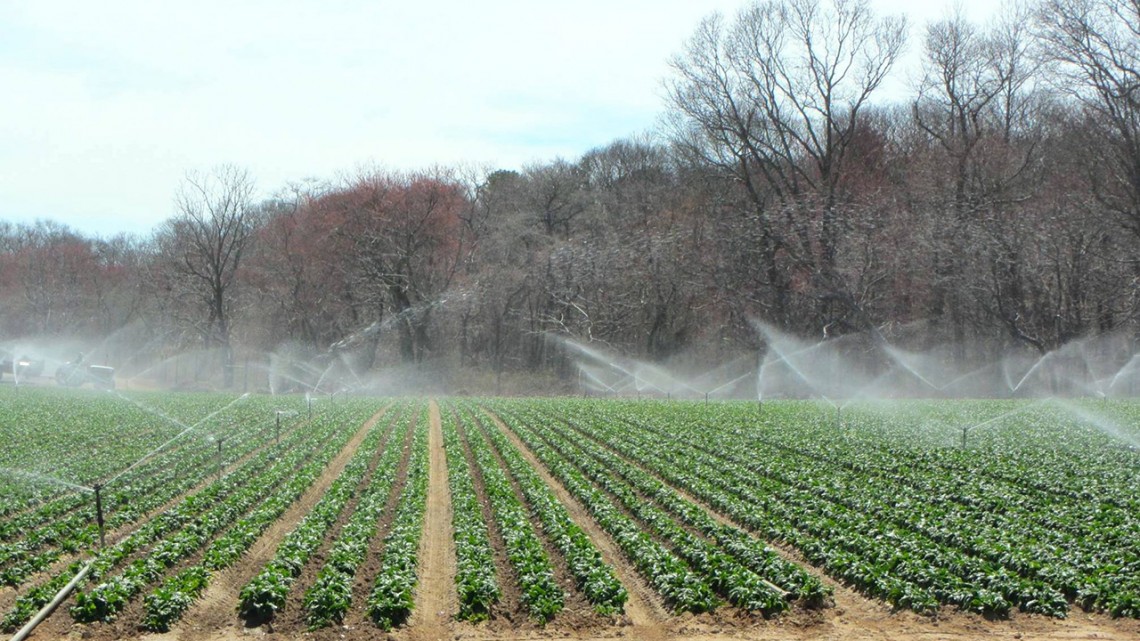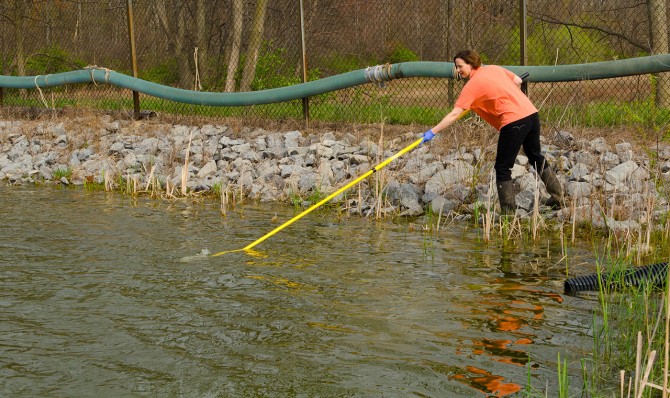
Sprays of water irrigate leafy greens overhead on a Long Island farm in Brookhaven, New York.
Produce Safety Alliance aims to demystify complex agriculture water rules
By Blaine Friedlander
In an effort to ensure the safety of fresh fruits and vegetables for consumers, Cornell’s Produce Safety Alliance is helping to explain complex federal food safety rules and develop new ways to assess agricultural water use.
“Water used during the production of fresh fruits and vegetables represents a potential pathway for contamination with human pathogens,” said Gretchen Wall, Cornell’s Produce Safety Alliance coordinator and lead author of “Key Outcomes From a Collaborative Summit on Agricultural Water Standards for Fresh Produce,” released in February in Comprehensive Reviews in Food Science and Food Safety, a journal published by the Institute of Food Technologists.
The work resulted from a two-day national meeting last year of growers, scientists, produce industry members and regulators on how to improve the Produce Safety Rule, specifically the agricultural water provisions, an important component of the Food Safety Modernization Act (FSMA).
In the Produce Safety Rule, Wall said, microbial quality standards and testing requirements were established so that when agricultural water makes contact with produce – whether in the growing, packing or holding phases of production – the risks associated with water are reduced. But some of the provisions in the regulation were difficult to understand and challenging to implement on farms, making it hard for farms to comply.
“The United States is a big place with many different water sources and systems,” said Betsy Bihn, senior extension associate and director of the Produce Safety Alliance, a collaboration between Cornell, the U.S. Food and Drug Administration, and the U.S. Department of Agriculture.
Bihn said farmers and producers draw their water from municipal sources, ponds, rivers, wells or other sources such as springs. Because their water can come from a variety of sources, the costs of testing and inspecting distribution systems and maintaining microbial quality standards can be expensive. Growers want to know that the money and time they are investing in water monitoring and testing is helping them make water management decisions that reduce produce safety risks, the report said.
Nationwide, the FDA estimates that water testing may cost producers about $37 million annually. For individual small farms, that could mean spending about $1,000 each year for testing, but it could substantially reduce the use of contaminated agricultural water and the risk of foodborne illness.
To keep testing costs reasonable, for example, stakeholders suggested allowing multiple farms that draw water from the same canal or river to share representative samples. In addition, stakeholders suggested better coordination and access to water quality data from irrigation districts, state or municipal agencies, and the Environmental Protection Agency.
Climate and geography are emerging as important components in agricultural water and food safety. “The impact of climate was one of the most frequently discussed priorities,” said Wall.
“Growers must now contend with more-frequent weather events, natural disasters and changing seasonal weather patterns that can impact precipitation volume and frequency, as well as pest pressure and disease prevalence,” Bihn said.
While the agricultural water segment of the Produce Safety Rule was approved in 2015, the FDA issued a statement on March 15 that will extend dates for agricultural water compliance on a national scale for large farms to January 2022, small farms to January 2023 and very small farms to January 2024.
“The FDA needs to take into consideration all of the regions of the country and how the agricultural water is used, and determine how risks may vary between regions. That’s why this new paper is relevant,” Wall said. “Those stakeholders who were at the summit have proposed some solutions for these complex problems. The FDA is still trying to sort this out, but water quality should remain a critical priority for all farms, despite the extension of compliance dates.”
In the interim, Bihn and her team continue to provide science-based educational materials and training for produce growers to raise awareness of agricultural water safety, and encourage action in managing food safety risks through testing water sources and conducting annual assessments of water systems.
In addition to Bihn and Wall, the paper’s co-authors are Cornell regional extension associates Donna Clements, Connie Fisk, Donald Stoeckel and Kristin Woods. This work was supported by the FDA, the Association of Food and Drug Officials, CompWALK.farm, the Produce Marketing Association and the United Fresh Produce Association
Media Contact
Get Cornell news delivered right to your inbox.
Subscribe

